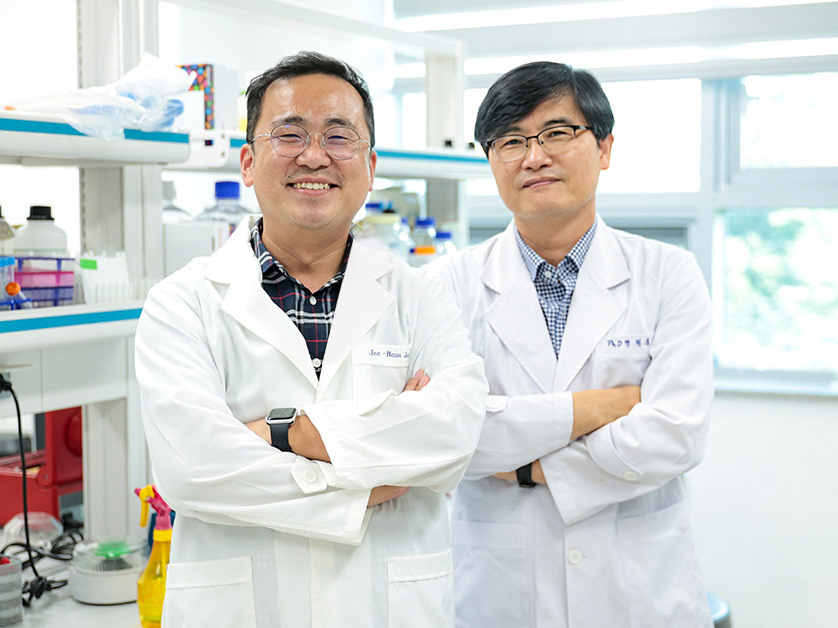YU Research Team Uncovers ‘Stem Cell Survival Rate Enhancement” Mechanism! N
No.90954- Writer pr
- Date : 2021.11.10 15:23
- Views : 8495
College of Pharmacy Professors Park Pil-hoon and Jung Ji-heon confirms mechanism for improving the survival rate for the ‘Mesenchymal Stem Cell Spheroid’
Accelerating development of drugs that induce activation of the autophagy through follow-up research
Published research paper in the internationally acclaimed journal, <Autophagy>
[October 7, 2021]
 <Professor Jung Ji-heon (left) and Professor Park Pil-hoon (left) of the YU College of Pharmacy>
<Professor Jung Ji-heon (left) and Professor Park Pil-hoon (left) of the YU College of Pharmacy>A research team at the YU College of Pharmacy found a way to improve the treatment efficiency of stem cell drugs.
Stem cells are being used as treatment drugs for various diseases. Among them, ‘mesenchymal stem cell’ has a number of advantages when using as treatment, and it is expected to be especially effective for treatment of degenerative neurological diseases and joint diseases such as Alzheimer’s and Parkinson's.
Mesenchymal stem cell has the weakness that cell death occurs in high amounts due to various causes after transplantation, thus lowering treatment efficiency. Several studies are being conducted to overcome this limitation. When applying 3D culturing using the spheroid method in which cells are hung upside down like drops and then the cells gather on the bottom due to gravity, it has been reported that stem cell treatment efficiency improves after transplantation. However, there is nothing known about the mechanism of spheroid culturing that improves cell survival rate and treatment efficiency.
The research team said, ‘It was found in this study that when culturing stem cells in the spheroid mode, ‘autophagy’, which is a self-digesting effect of cells, occurs and this autophagy significantly suppresses cell death to increase cell survival rates.It was verified for the first time that treatment efficiency was enhanced through this for the first time in a colitis treatment animal model.”
This study was joined by Dr. Regmi Shobha (currently a post-doctorate researcher at Stanford University) who earned his PhD at the YU Graduate School of Pharmacy and Dr. Raut Pawan Kumar (currently post-doctorate researcher at Keimyung University) as the joint first authors, and Professors Park Pil-hoon and Jung Ji-heon of the YU College of Pharmacy as joint correspondence authors.
Professor Jung Ji-heon stated, "The market for developing treatment using stem cells is expanding globally, but because of the low survival rate after cell treatment transplantation, there were difficulties in the commercialization of the stem treatment drug. The results of this study will help accelerate development of drugs that will induce autophagy activity,” while adding, “It is expected that post-cell treatment drug transplantation will improve the survival rate of stem cells and enhance treatment efficiency.”
In particular, this study was the result of the convergence research of the research teams of Professor Park Pil-hoon who is carrying out ‘investigative research on the signal delivery system that adjusts cell survival and death’ and Professor Jung Ji0-heon who is engaged in the ‘research for developing drugs using mesenchymal stem cell.’ The research team plans to conduct joint research that will explain the mechanism for improving survival rates of cell drugs to establish cell treatment as a new disease treatment drug.
This study was conducted with the support of the National Research Foundation new researcher support project, Ministry of Education's stage 4 BK21 project, College central research center support project (YU Cell Culture Lab), and the natural material medical material core research support center (CRCNM). The research results were released online in the internationally acclaimed academic journal <Autophagy (impact factor (IF) 16.016)> under the title ‘Improvement of Survival Rate and Functions of Mesenchymal Stem Cells for spheroid culturing through Autophagy paths.’